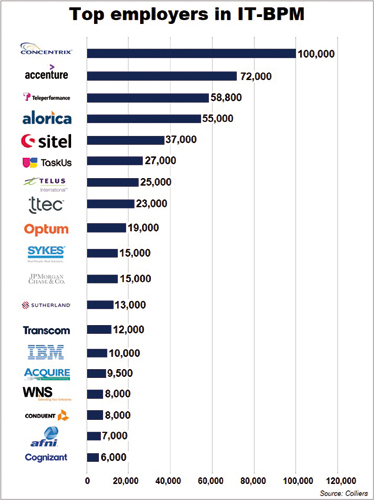The information technology-business process management (IT-BPM) sector would continue to drive growth in employment in the next 18 months, according to JobsFit 2022-2025 Labor Market Information (LMI) Report, a flagship publication of the the Department of Labor and Employment.
The LMI which contains information on key employment generating sectors, emerging industries, in-demand and hard-to-fill occupations, also identified the following as the key growth drivers: energy, healthcare, consumer goods and industrial manufacturing, wholesale and retail trade, construction and real estate, financial services, aerospace, agro-processing and construction.
Grace Baldoza, head of the LMI research division of BLE, in a recent forum, highlighted the outlook for some sectors.
According to Baldoza, agriculture remains one of the largest industries by employment share, at 22.5 percent of total employment as of September 2022.
She, however, noted youth engagement efforts must be intensified by furthering education, training, and extension programs to equip young farmer leaders and agripreneurs with the necessary skills to attract and encourage the younger population to pursue agribusiness opportunities.
Baldoza said banks expect double-digit growth over the next two years as the government strengthens digitalization efforts which will facilitate the growth of fintech businesses.
The report said the construction industry gained employment by 9.9 percent as of September, slowly recovering after experiencing a decline during the pandemic
The construction sector is forecast to record a real annual average growth of 7.6 percent between 2023 and 2025 with real construction output expected to surpass its pre-pandemic value by 2023. 2020.
In education, the Department of Education aims to hire thousands of teachers nationwide to fill up vacancies and have an adequate workforce for the school year 2022-2023.
Baldoza said the healthcare sector has significant long-term potential for growth but the pandemic has revealed gaps across the payer, provider, and pharma ecosystems, which all declined in 2020.
The hotel, restaurant, and tourism sector which accounts for 11 percent of total employment, saw an increase of 4.6 percent in workforce in 2021, to 4.895 million from 4.681 million in 2020.
The job market looks rosy as the Department of Tourism forecasts the recovery of the country’s domestic travel sector by 2022 at the earliest and by 2024 at the latest.
After a record-high growth in 2021, the IT-BPM industry is projected to increase between 7 and 8 percent in terms of full-time employees and 8 and 10 percent in terms of revenue by the end of the year. It is poised to grow into a $59-billion industry, with 1.1 million new direct jobs, a 2.5 million-strong workforce, over 500,000 new direct jobs for the countryside, and up to 3 million more indirect jobs.
Baldoza said artificial Intelligence has the potential to be the number one growth driver.
For the manufacturing sector, firms reported an improvement in operating conditions in September primarily driven by domestic demand.
Logistics services will continue to be in demand as a result of the further loosening of pandemic restrictions, said Baldoza. The logistics and warehousing industry will continue to have an indispensable function in the “new normal” in various sectors including automotive, electronics, chemicals, pharmaceuticals and clothing and accessories.
The wholesale and retail trade is seen to drive 18 percent of the economy. There will be an increasing shift from shopping in malls and supermarkets to online channels and neighborhood resellers.
Baldoza cited the Department of Trade and Industry’s Business Name Registration System database showed that business name registrations has increased, with 305,058 out of a total 574,322 being new business registrations as of July 2022. – Irma Isip




